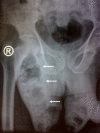Fournier Gangrene in the Emergency Department: Diagnostic Dilemmas, Treatments and Current Perspectives
- PMID: 33204184
- PMCID: PMC7665443
- DOI: 10.2147/OAEM.S238699
Fournier Gangrene in the Emergency Department: Diagnostic Dilemmas, Treatments and Current Perspectives
Abstract
Fournier gangrene (FG) is a rare and life-threatening urosurgical emergency characterized most often by a polymicrobial infection of the perineal, genital, or perianal region. FG has an increased incidence in male patients, patients with alcoholism, and patients with immunocompromise including human immunodeficiency virus (HIV) and uncontrolled diabetes. FG often begins as a simple abscess or cellulitis with progression to necrotizing soft tissue infection (NSTI). Delays in diagnosis and treatment confer high mortality. Early recognition and high clinical suspicion are important in making a timely diagnosis, as early manifestations are often subtle. The most significant modifiable risk factor associated with NSTI mortality is delay to surgical intervention. Coordination of both inpatient medical and surgical teams to implement appropriate therapy is vital to successful outcomes. The emergency medicine clinician must be vigilant for this condition and be aware of risk factors, prognostic indicators, and proper treatment protocols to recognize FG early and initiate appropriate management. The objective of this review is to provide updated and relevant information regarding recognition, diagnosis, and management of FG for the emergency medicine provider.
Keywords: emergency; infectious disease; necrotizing fasciitis; necrotizing soft tissue infections.
© 2020 Auerbach et al.
Conflict of interest statement
The authors report no conflicts of interest in this work.
Figures




References
-
- Filippone LM. MD diagnosis: Fournier’s gangrene. Emerg Med News. 2005;27(5):36. doi:10.1097/00132981-200505000-00029 - DOI
Publication types
LinkOut - more resources
Full Text Sources

